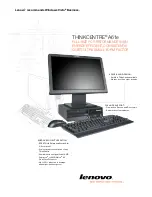
ANCP is an extension to GSMPv3 that functions as a control plane between a
service-oriented layer 3 edge device (the Broadband Remote Access Server) and a
layer 2 access node. In this role, ANCP performs QoS-related, service-related, and
subscriber-related operations. These operations include the following:
■
Dynamic discovery of the access topology and enabling an authentication server
to retrieve this information
■
Subscriber and service data retrieval from the OSS by the Broadband Remote
Access Server (B-RAS) and sending that information to the access node to simplify
service management (referred to as line configuration)
■
An optimized, layer 2 multicast (IGMP) replication
■
On-demand access-line testing (ANCP Operation, Administration, and
Maintenance)
JUNOSe software supports the use of RADIUS attributes to monitor ANCP-related
information, such as upstream and downstream data rates. For information about
using RADIUS attributes see
JUNOSe Broadband Access Configuration Guide
.
Access Topology Discovery
Many queuing or scheduling mechanisms must avoid congestion within the access
network while contending with multiple flows and distinct QoS requirements. These
mechanisms require that B-RAS devices obtain information about the access network
topology, the links within that network, and their rates.
Operations support systems cannot enforce the consistency of this gathered
information in a reliable and scalable way. ANCP discovery enables the automated
discovery of the access network topology, resolving this problem.
Line Configuration
Following access topology discovery, the B-RAS can query a subscriber management
OSS component (for example, a RADIUS server) to retrieve subscriber authorization
data. This type of query is typically managed by the B-RAS, but in some cases (for
example, DSL-related enforcement) it can be useful to push service information to
the access node for local enforcement of the corresponding subscriber line. Using
the line configuration feature provides a more flexible way to achieve this on-demand
service.
NOTE:
JUNOSe software supports only a CLI version of this feature.
Transactional Multicast
IP multicasting in access networks often involves an access server replicating the
same multicast stream to multiple subscribers. This type of replication wastes access
bandwidth when multiple subscribers access network services using the same access
node. The amount of multicast replication is based on the number of subscribers,
rather than the number of access nodes.
194
■
Overview
JUNOSe 11.1.x IP Services Configuration Guide
Summary of Contents for IP SERVICES - CONFIGURATION GUIDE V 11.1.X
Page 6: ...vi...
Page 8: ...viii JUNOSe 11 1 x IP Services Configuration Guide...
Page 18: ...xviii Table of Contents JUNOSe 11 1 x IP Services Configuration Guide...
Page 20: ...xx List of Figures JUNOSe 11 1 x IP Services Configuration Guide...
Page 22: ...xxii List of Tables JUNOSe 11 1 x IP Services Configuration Guide...
Page 28: ...2 Chapters JUNOSe 11 1 x IP Services Configuration Guide...
Page 138: ...112 Monitoring J Flow Statistics JUNOSe 11 1 x IP Services Configuration Guide...
Page 286: ...260 Monitoring IP Tunnels JUNOSe 11 1 x IP Services Configuration Guide...
Page 312: ...286 Monitoring IP Reassembly JUNOSe 11 1 x IP Services Configuration Guide...
Page 357: ...Part 2 Index Index on page 333 Index 331...
Page 358: ...332 Index JUNOSe 11 1 x IP Services Configuration Guide...
















































